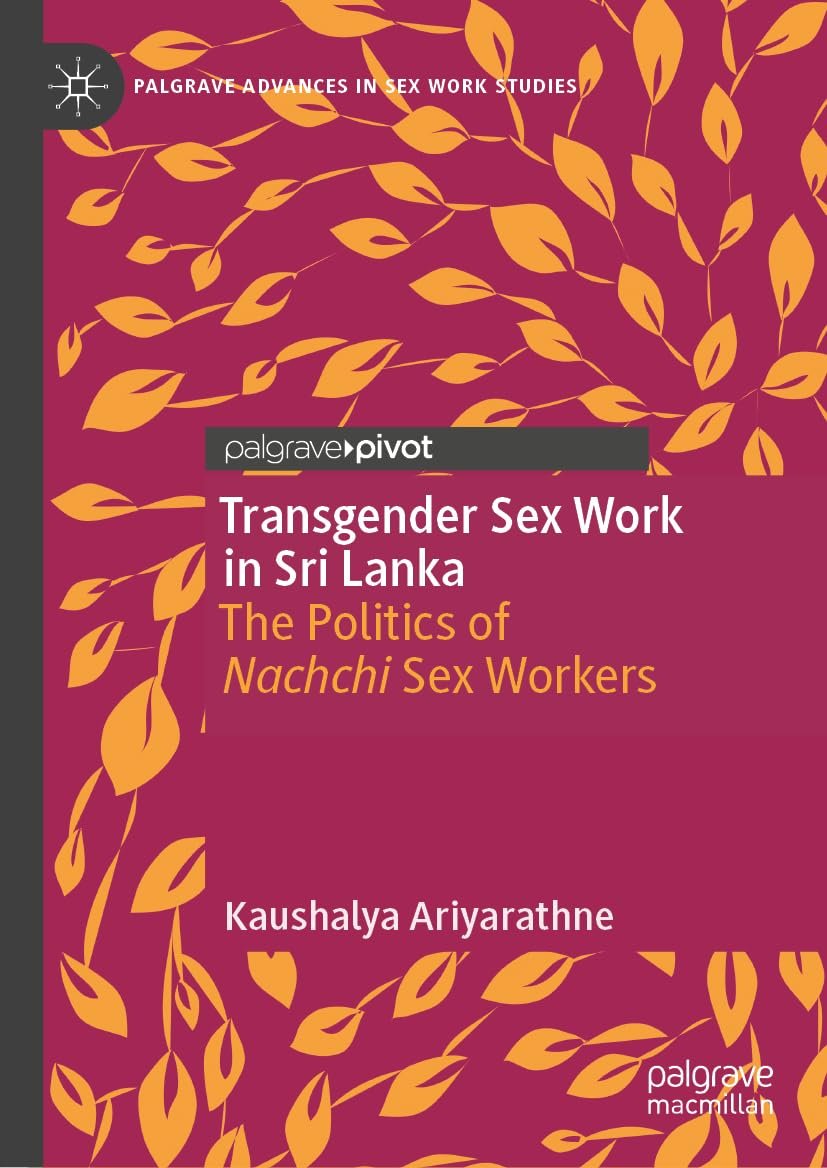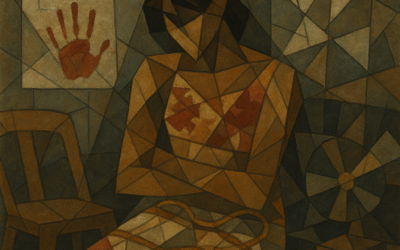Transgender Sex Work in Sri Lanka: The Politics of Nachchi Sex Workers. Kaushalya Ariyarathne. Palgrave Macmillan, 2025.
F. Zahrah Rizwan
Groundbreaking is the word that echoes through Kaushalya Ariyarathne’s book, Transgender Sex Work in Sri Lanka: The Politics of Nachchi Sex Workers. This is not only because it is the first of its kind written by a Sri Lankan scholar, but because it dares to sit with the messy, layered, and intersectional realities of Nachchi sex workers’ lives. Ariyarathne refuses the temptation to reduce these experiences into tidy categories. Instead, she situates them within a complex web of gender, sexuality, pleasure, culture, and politics. What makes this project so powerful to me is the lens through which it is written. Ariyarathne wears many hats. At the point of writing the book, she was a human rights activist, a researcher, an attorney-at-law, and an academic. When she wrote the last chapter, she was an elected member of the parliament of Sri Lanka representing the ruling party, the National People’s Power (NPP). These shifting positionalities set her work apart from conventional scholarship. Rather than writing about lives from afar, the book brings together lived political struggles of the Nachchi through these different positionalities of the author, while still engaging with theoretical debates.
In this review, I aim to examine the central arguments of the book, consider its significance for scholarship on gender and sex work, and reflect on why it stands out as such a significant intervention in feminist thinking on queerness and sex work. I write, too, from the vantage point of my own doctoral research that involves Nachchi sex workers, which makes this process both intellectually and personally meaningful.
The book comprises seven chapters, each opening a different entryway to Nachchi experiences. The introduction lays the groundwork, locating Nachchi realities within Sri Lanka’s colonial backdrop, religious and cultural traditions, and the pressures of present-day economic and geopolitical crises. Chapter 2 dives into the personal, how Nachchi narrate and negotiate agency in ways that refuse simple binaries of victimhood and empowerment. Chapter 3 lingers on language, showing how the linguistic practices of Nachchis create a distinct “speech community” that asserts belonging and identity. From there, the book turns to embodied expression. Chapter 4 explores jogi dance at the intersections of culture, sexuality and economics, while Chapter 5 illuminates the spiritual force of Kali goddess worship in Nachchi worlds. Chapter 6 shifts focus to the state, outlining the precarious encounters between Nachchi sex workers and legal systems that often criminalise or erase them. The book closes in a strikingly self-reflexive tone, where Ariyarathne reflects on her own “shifting positionalities” (2025: 19). In this moment, the boundaries between researcher, advocate, and political actor dissolve, reminding us that scholarship itself is always political, always personal.
Ariyarathne adopts a qualitative, ethnographic methodology to study Nachchi, drawing extensively on her long-standing interactions with them across both professional and personal contexts. Given the scarcity of local scholarship on non-binary identities and sex work in Sri Lanka, she positions ethnography not only as a deliberate choice but also as a necessary approach. Her methodology is deeply informed by local dynamics, allowing her to capture the nuanced, situated experiences of Nachchi while critically reflecting on the intersections of identity, labor, and cultural practice.
Ariyarathne situates Nachchi within Sri Lanka’s broader socio-political and cultural landscape, tracing how colonialism, Christianity, and nationalist moralities have shaped dominant discourses on sexuality and gender. Drawing on Jody Miller and Andrea Nichols (2012), she explains Nachchi as “individuals assigned male at birth who identify as females”, embrace feminine subjectivities and simultaneously acknowledge their ‘biological maleness’ and desire for male sexual partners. She does this by being transparent about the challenges of writing to an “external gaze” (Ariyarathne 2025: 2).
While NGOs and global rights frameworks have introduced the term transgender as a category that offers visibility, access to services, and recognition, Ariyarathne acknowledges its limits, pointing out how such vocabulary risks erasing non-normative, local identities that do not neatly align with Western discourses. Importantly, she notes the fluidity of Nachchi themselves, who discard or substitute these labels when necessary (28). Even the title of the book reflects the tensions Ariyarathne had to navigate: “Nachchi” and “sex work” bring together two fields of inquiry, while the choice of “transgender” as an umbrella term opens another layer of complexity, signalling to NGO discourses, Western conceptual framings, donor agendas, and their entanglement with state policymaking in Sri Lanka.
Ariyarathne critiques the donor-driven funding landscape, which has centered on HIV prevention and the rhetoric of “rescuing” vulnerable communities, often reproducing narratives of exploitation rather than dismantling structural barriers (29). She frames rights not as an end goal but as a form of “critical counter-conduct”, arguing that feminist and human rights discourses frequently reduce agency to basic survival and access to rights. Instead, she theorises agency as a “dynamic, polygonal process” encompassing choice, autonomy, and resistance in context-specific ways (41). This theorisation challenges both state-driven Sinhala Buddhist hegemonies and feminist discourses that conflate sex work with commercial sexual exploitation. By situating kinship, pleasure, and intimacy within sex work, highlighting the mother-figure hierarchy that both nurtures and prepares Nachchi for sex work, Ariyarathne extends sex work scholarship beyond binary frameworks, victim versus agent, exploitation versus empowerment, and instead foregrounds the ways Nachchi find joy, romance, and self-affirmation in sex work.
One of the book’s greatest strengths lies in its originality and voice. Ariyarathne brings into scholarly discourse rare insider narratives of Nachchi whose lives are often erased or homogenised in mainstream and feminist literature. She manages to balance conceptual sophistication with grounded ethnographic accounts, offering a text that is both theoretically rich and deeply humanising. From the outset, she acknowledges the difficulty of navigating “accuracy and accessibility” (5) when writing about a community that exists outside Western conceptualisations of gender and sexuality. Her insistence that community for Nachchi is both protective and constraining, empowering and vulnerable, captures the ambivalent texture of everyday life and resists reductive portrayals. Conceptually, the book succeeds in linking decolonial feminist thought with the embodied, situated experiences of Nachchi sex workers. The refusal to reduce sex work to mere “commercial sexual exploitation” is an important intervention in both global and Sri Lankan feminist debates.
Her analysis of language is another major contribution. By treating Nachchi lingua as both a mode of belonging and exclusion, Ariyarathne shows how identity is internally policed and externally contested. Proficiency in this language becomes a marker of authenticity, while its use of obscene or transgressive speech functions as an act of resistance against insults, creating solidarity with cis women sex workers as well (59). She extends this analysis to non-verbal cues: eye make-up, gestures, bodily movements, which serve not only to attract clients but also to fulfill sexual desires and act as strategic “weapons” in navigating daily life (54). This nuanced attention to performativity builds on South Asian scholarship on Hijras while carving out space for the specificities of Nachchi.
The chapters on dancing and ritual further illuminate the intersections of culture, religion, and queer embodiment. Ariyarathne’s analysis of jogi dance situates it within Sri Lankan religious and cultural histories, while showing how Nachchi transform these performances into “transgressive moments” that allow them to negotiate non-binary identities in public spaces and experience pleasure (87). Similarly, her exploration of Kali worship underscores how Nachchi draw on myth, ritual, and sorcery to navigate injustice in contexts where state institutions have failed them. The juxtaposition of justice and revenge highlights how alternative spiritual practices become forms of recourse and survival when formal systems are either inaccessible or hostile.
Another strength is Ariyarathne’s reflexivity. She does not shy away from acknowledging her positionalities as a Sinhala-speaking, cisgender woman, lawyer, and now legislator. Her recognition of the limits of her own ontological frameworks, particularly her struggle to comprehend how joy and pleasure could coexist with the dangers of sex work (35), adds depth to the ethnography. This self-reflection prevents romanticisation of communal life, acknowledging that solidarity exists alongside conflict and precarity.
Unanswered questions
At times, the distinctions between transgender, Nachchi, and Nachchi sex worker blur in ways that risk flattening the diversity of these overlapping but distinct identities. The text makes clear that this merging is partly to reach a global audience and to situate LGBTQ+ activism in Sri Lanka within global activism. Yet the book leaves unanswered questions about the role of Nachchi within wider transgender and queer movements, especially since the conflation of Nachchi and sex work has often pushed them to the margins of activism. Methodologically, Ariyarathne’s closeness to her interlocutors, whom she calls “my Nachchi friends”, sits uneasily with the visible differences relating to class, education, and professional status. Despite years of relationship-building, her role as both advocate and researcher highlights questions of power dynamics, ethics, and consent. Were Nachchi always aware that their casual interactions would be quoted in scholarship? Could a framing that emphasised collaboration, rather than friendship, have better reflected the shared but unequal relationship dynamics and process of knowledge-making?
Geographically, the book stays rooted in Colombo, leaving open whether Nachchi experiences elsewhere in Sri Lanka look different. Similarly, the discussion of Kali worship and sorcery as routes to justice (2025: 104) could have gone further: how different are these practices from the individualising focus of criminal law or the victim–perpetrator logics of radical feminism and feminist movements such as #MeToo? This moment could have been used to critique how formal justice systems themselves often fail marginalised groups like the Nachchi. While the book powerfully critiques the state and the NGO sector, it says little about what this might mean for future reform. Could recognition of Nachchi kinship and agency reshape debates on gender certificates, anti-discrimination laws, or sex work decriminalisation?
Citing Rahul Rao (2015), Ariyarathne brings in homocapitalism as a conceptual frame to present how LGBTQ rights movement has been “co-opted and commodified within capitalist frameworks” (2025: 129). In light of the recent furore in Sri Lanka with regard to LGBTQ+ inclusivity in the tourism sector (Law & Society Trust 2025), what does this mean for local LGBTQ communities who continue to be criminalised by colonial laws that are yet to be repealed by the government? How does the government’s capitulation to religious and lay opposition to the now discarded policy align with the NPP manifesto commitment to decriminalisation of same-sex relations through reform of the Penal Code (2025: 137)?
In the concluding chapter, Ariyarathne provides a self-reflective account written more recently, looking back at the years she spent writing this book. I see this chapter really bolstering the book as it ties together her many positionalities that offer opportunities as well as challenges to her intellectual projects and the political spaces she occupies. She treads quite carefully when sharing internal views and politics of the NPP, the political party she represents, and of whose government she has recently been appointed deputy minister of mass media. Ariyarathne insists that “sex work is not solely a product of economic coercion but can also be a space of choice, pleasure, and desire” (137). The opposition expressed by party members to the legalisation of sex work, framed largely through their leftist ideology, can also be read as an instance that reflects internalised stigma toward sex work. These views can be further unpacked as ways to police gender, sexuality and sexual practices in an attempt to protect the heteronormative monogamous family structures, inherited from the British colonial past.
Ariyarathne goes on to say that “NPP government faces the significant and complex challenge of advancing these legal reforms within a paradoxical landscape—where a leftist administration, grounded in the ideology of fundamental equality, must navigate the expectations of a support base largely composed of the Sinhala-Buddhist majority” (138). I find this statement full of contradictions and paradoxes as a whole. It raises numerous questions. How can ‘equality’ be achieved if it is dependent on the ‘Sinhala Buddhists’ whose privilege is founded on majoritarianism? As the ruling party holding the majority of seats in parliament, the NPP has a responsibility towards ensuring equality toward all citizens. Does that not include Nachchi sex workers? The ending of the book leaves the reader wondering if the transgender community in Sri Lanka (who also showed overwhelming support toward Ariyarathne’s run for elections) with “deep-seated hope for meaningful justice and transformative change in their lives—justice that moves beyond tokenistic recognition to real, substantive progress” (137) would ever see this reality.
This section of the book could have been a window of opportunity to call for a radical reimagining of party politics. Such a critique might have disentangled leftist from colonial stigmas, demanding instead a more robust engagement with present-day realities. Without this, the wholesale reliance on ideology risks functioning as a shield against confronting urgent issues such as sex work—issues that will continue to heighten risks for those in the trade so long as sex work remains criminalised and stigmatised.
Despite these omissions, this book remains a landmark study, and I commend Ariyarathne for taking on this project – especially given her positionalities. The significance of the book is both academic and practical: it expands South Asian queer and sex work studies, unsettles dominant narratives, and offers insights for policymakers, activists and academics alike. Above all, it insists on the complexity, creativity, and resilience of Nachchi lives. For me, as a feminist researcher and scholar working on Nachchi sex workers, this text is not just an analysis but a steppingstone for future research.
F. Zahrah Rizwan is a doctoral student in the Women’s Gender & Sexuality Studies Department at Ohio State University, USA. Her research interests include exploring the intersections of colonialism, racial capitalism and contemporary crises within sex work economies in Sri Lanka. She comes from an interdisciplinary background in Gender studies, English and Business and has been involved in activist spaces in Sri Lanka as a feminist researcher.
References
Law & Society Trust. (2025). The Right to Equality and the Hospitality / Tourism Industry. (17 October). Available at https://lst.lk/the-right-to-equality-and-the-hospitality-tourism-industry-public-statement-singed-by-108-individuals-and-29-sco/
Miller, Jody, and Andrea Nichols. (2012). “Identity, sexuality and commercial sex among Sri Lankan nachchi.” Sexualities, 15 (5–6): 554–569.
Rao, Rahul. (2015). “Global Homocapitalism.” Radical Philosophy, 194: 38–49.
You May Also Like…
Safety is Not a Wall: Beyond Protection from Domestic Violence
Prasanna Pitigala Liyanage
Call her N.The night she left, she packed her phone, her NIC, and a small bag.A friend waited in a trishaw.At the...
“There is nothing inherently liberatory in the imagination, but it must be made so”
Vajra Chandrasekera
From the Editors: Our warm congratulations to Vajra Chandrasekera, whose writing we have been pleased to feature, on...
End the Microfinance Menace! No to the new Bill!
Feminist Collective for Economic Justice
The National People’s Party (NPP) marked the completion of its first year in government in September 2025. Sadly, the...




